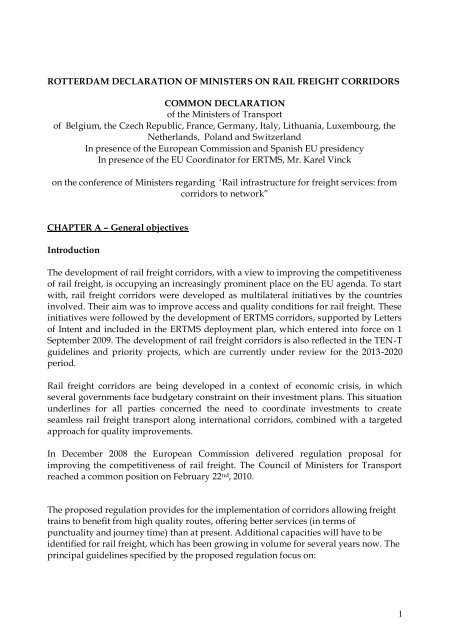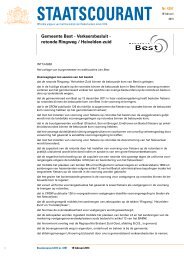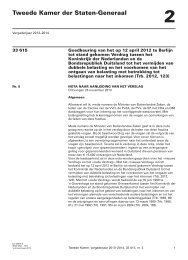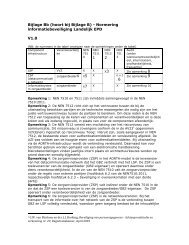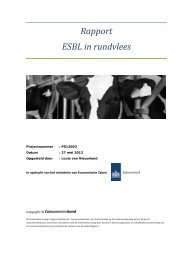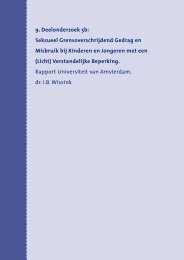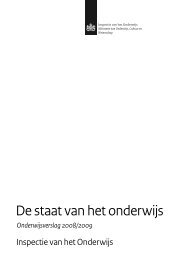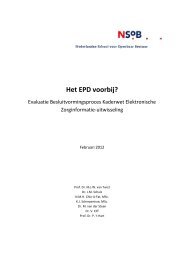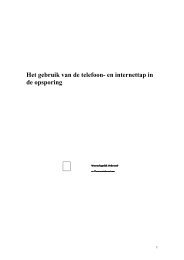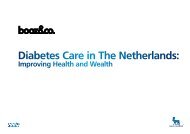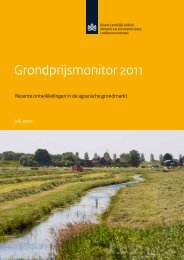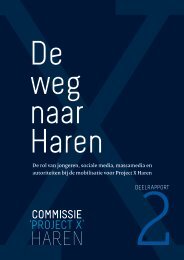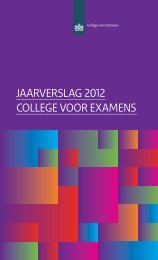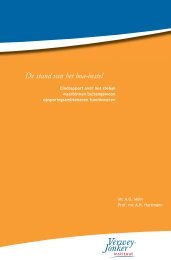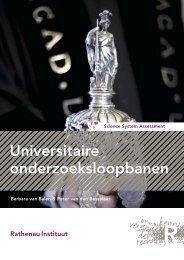1 ROTTERDAM DECLARATION OF MINISTERS ... - Rijksoverheid.nl
1 ROTTERDAM DECLARATION OF MINISTERS ... - Rijksoverheid.nl
1 ROTTERDAM DECLARATION OF MINISTERS ... - Rijksoverheid.nl
- No tags were found...
Create successful ePaper yourself
Turn your PDF publications into a flip-book with our unique Google optimized e-Paper software.
<strong>ROTTERDAM</strong> <strong>DECLARATION</strong> <strong>OF</strong> <strong>MINISTERS</strong> ON RAIL FREIGHT CORRIDORSCOMMON <strong>DECLARATION</strong>of the Ministers of Transportof Belgium, the Czech Republic, France, Germany, Italy, Lithuania, Luxembourg, theNetherlands, Poland and SwitzerlandIn presence of the European Commission and Spanish EU presidencyIn presence of the EU Coordinator for ERTMS, Mr. Karel Vinckon the conference of Ministers regarding ‘Rail infrastructure for freight services: fromcorridors to network”CHAPTER A – General objectivesIntroductionThe development of rail freight corridors, with a view to improving the competitivenessof rail freight, is occupying an increasingly prominent place on the EU agenda. To startwith, rail freight corridors were developed as multilateral initiatives by the countriesinvolved. Their aim was to improve access and quality conditions for rail freight. Theseinitiatives were followed by the development of ERTMS corridors, supported by Lettersof Intent and included in the ERTMS deployment plan, which entered into force on 1September 2009. The development of rail freight corridors is also reflected in the TEN-Tguidelines and priority projects, which are currently under review for the 2013-2020period.Rail freight corridors are being developed in a context of economic crisis, in whichseveral governments face budgetary constraint on their investment plans. This situationunderlines for all parties concerned the need to coordinate investments to createseamless rail freight transport along international corridors, combined with a targetedapproach for quality improvements.In December 2008 the European Commission delivered regulation proposal forimproving the competitiveness of rail freight. The Council of Ministers for Transportreached a common position on February 22 nd , 2010.The proposed regulation provides for the implementation of corridors allowing freighttrains to benefit from high quality routes, offering better services (in terms ofpunctuality and journey time) than at present. Additional capacities will have to beidentified for rail freight, which has been growing in volume for several years now. Theprincipal guidelines specified by the proposed regulation focus on:1
- closer cooperation and harmonisation between infrastructure managers and memberstates both for the operational management of the infrastructures and for investments,in particular by putting in place a governance structure for each corridor;- increased coordination between the network and terminals (maritime and i<strong>nl</strong>and portsand marshalling yards etc.);- the reliability of the infrastructure capacities allocated to freight on these corridors.The Ministers1. recognise the contribution of rail freight to Europe’s socioeconomic developmentand to the environment (and in particular its potential contribution to combatingclimate change);2. stress the high potential of the rail freight corridors to link more effectively theexisting TEN-T priority projects and thus to contribute to the formation of acoherent TEN-T network;3. share the ambition to work together to develop a network of rail freight corridorsthroughout Europe in order to achieve seamless transport by interoperability, theremoval of bottlenecks, the harmonisation of operational rules, and capacitymanagement;4. while pursuing that common goal, aim at optimal implementation of allrelevant EU policies (TEN-T, ERTMS, proposed EU regulation concerning aEuropean rail network for competitive freight etc.);5. will involve the business community in developing the rail freight corridors;6. stress that the development of rail freight corridors should be properly fundedalthough this declaration does not imply additional financing by the Statesu<strong>nl</strong>ess expressly stated;7. consider that this declaration is without prejudice to the competence of theMember States regarding planning and funding of rail infrastructure.CHAPTER B - Common governance aspects for the EU rail freight corridors 1. The European Union member states involved in this declaration welcome thefirst reading of the proposed EU regulation towards a European network forcompetitive freight and will adopt a common approach to its implementationonce the Council, the European Parliament and the European Commission haveenacted the legislation. Within the process of the EU-Swiss dialogue ontransport, Switzerland will consider adoption of the EU regulation by examiningwhich provisions of its laws should be amended accordingly. Until such time,Switzerland will work as far as legally possible with the EU Member Statesconcerned within the framework of this regulation, in advance of adoption.2. The rail freight corridors nos. 1, 2 and 8, referred to in Annex I of the proposedregulation, overlap partly or completely other initiatives, such as the ERTMScorridors A, C and F, the RailNetEurope (RNE) corridors nos. C02, C05 and C03,2
the Rotterdam-Lyon (Ro-Ly) railway link etc. The Member States, infrastructuremanagers and governance bodies involved in these initiatives will aim toharmonise approaches and rationalise governance in order to facilitate thefunctioning of the corridors.3. Each of the proposed regulation’s freight corridors will be provided with thegovernance structure and planning that matches its particular situation.4. The proposed objective is to connect the regulation’s individual freight corridorsin terms of interoperability and capacity management, with governanceprimarily geared to each individual corridor.CHAPTER C1 – Axis n° 1 / ERTMS corridor A / TEN-T Priority project n° 24 / RNE-2(Zeebrugge - Antwerp/Rotterdam-Duisburg-[Basel]-Milan-Genova)Chapter C1 is o<strong>nl</strong>y the responsibility of the Ministers of Belgium, the Netherlands,Germany, Switzerland and Italy.Given:TEN-T Priority Project no. 24: railway axis Lyon/Genoa-Basel-Duisburg-Rotterdam/Antwerp (Decision no 1692/96/EC);that the Ministers signed the Genoa declaration concerning the Rotterdam-Genoa corridor on 26 May 2009;that the Ministers signed the Letter Of Intent regarding the deployment ofERTMS on 3 March 2006;that the Rotterdam-Genoa executive board adopted its mission statement on30 November 2006, identifying its objectives, roles and decision-makingprocedures on the basis of consensus;RNE corridor C02 - Rotterdam/Antwerp-Ruhr Area-Milan-Genoa;that an advisory board and terminal platform were to be set up by 2009;that a corridor noise study is finished in June 2010;that an ERTMS corridor authorisation group has been set up under theleadership of the corridor NSAs.The Dutch, German, Swiss and Italian Ministers decide to:1. continue to support the needed solid implementation of financial decisionsregarding the implementation of ERTMS on the corridor per 2015 and aftercompletion of the financial framework to request the Infrastructure Managers tomake the ERTMS corridor implementation plan public;2. adopt the annexed Annual report 2009 of the Rotterdam – Genoa Corridor;3. amend the annexed corridor updated action plan Rotterdam – Genoa 2008– 2012for the 2010 – 2014 period with strong focus on achieving tangible benefits forrailway undertakings at short term combined with medium / long termdevelopment of infrastructure capacity and interoperability;3
4. adopt the annexed framework for testing and authorising deployment of ERTMSon both infrastructure and rolling stock in the 2010-2015 period, led by the NSAauthorisation group. Cooperation with ERA is crucial for its success;5. request the Infrastructure Managers to continue to cooperate on procurementaspects of ERTMS with the objective of mitigating joint risks of ERTMSimplementation;6. endeavour to enable to run long trains at the corridor by providing at least 750meters long tracks according to the UN ECE AGC recommended standard ontrain length. To achieve this it will be crucial that Infrastructure Managers shallcome with an implementation plan, based on a corridor cost-benefit analysis alsouseful to define a possible common target date;7. invite Belgium to participate as an observer, and as full member after the entryinto force of the proposed regulation, in the executive board of corridorRotterdam - Genoa and therefore ask the Infrastructure Managers, in cooperationwith Infrabel, to propose to the executive board by the end of 2010 a plan for theextension of the corridor to Antwerp / Zeebrugge to be established via theBelgian – German border. The plan should include definition of routes,participation in corridor organisation structure and take into account the actionplan 2010 – 2014 for the corridor.The Belgian Minister accepts the invitation and endorses the above-mentioneddecisions.CHAPTER C.2 – Axis n° 2 / ERTMS corridor C / Ro-Ly / TEN-T Priority project n° 28 /RNE-5(Rotterdam-Antwerpen-Luxemburg-Metz-Dijon-Lyon/[Basel]Chapter C2 is o<strong>nl</strong>y the responsibility of the Ministers of Belgium, The Netherlands,Luxembourg, Switzerland and France.GivenLetter Of Intent ERTMS 9 th June 2006;considering the RNE-5 initiative supporting the development of rail freight in thearea Rotterdam – Antwerpen – Luxembourg – Metz – Dijon – Lyon and furtherto Spain and Italy, whereas ERTMS corridor C, in its present configuration, aimsat supporting a similar development in the area Antwerpen - Luxembourg/Paris- Lyon/Basel;considering the objectives of the Rotterdam-Lyon rail freight corridor (Ro-Ly) onthe improvement of quality and access conditions of the corridor based on theobjectives as set by the memorandum of understanding between Ministerssigned 10 th December 2004 as well as the progress reports 2005-2006 and 2007-2008 ;4
TEN-T Priority Project no. 28, the Eurocap-Rail passenger rail axis on theBrussels-Luxembourg-Strasbourg railway axis (Decision no 1692/96/EC), part ofwhich can be used as an alternative route for corridor C;considering the decision of the French government in the framework of hisnational commitment for the rail freight of 16th September 2009 to promote therail connection of his sea-ports;taking into consideration the Strategic Policy Paper of the Belgian Secretary ofState for Mobility, in particular its part on the development of the rail freightcorridors and their importance for the Belgian sea-ports.The Belgian, Luxemburg, Swiss and French Ministers decide to:1. reconfirm their commitment to deploying ERTMS on the corridor as planned inthe European deployment plan (except for the branch to Lyon, where ERTMSwill not be deployed until 2018);2. adopt the annexed Annual Report 2009 of Corridor C;3. take into consideration the annexed integrated corridor action plan includingboth ERTMS (2010-2018) / infrastructure development actions and qualityimprovement actions (2010-2013);4. charge the executive board and the management board of Corridor C, composedof representatives of the Infrastructure Managers involved in the corridor, to takeover the monitoring activities of the Ro-Ly initiative and cooperate with thenational safety authorities and regulatory bodies;5. endeavour to enable to run long trains at the corridor by providing at least 750meters long tracks according to the UN ECE AGC recommended standard ontrain length by the target date of 2016;6. invite the Netherlands to participate as an observer, and as full member after theentry into force of the proposed regulation, in the executive board of corridorAntwerp - Lyon / Basel and therefore ask the Infrastructure Managers, incooperation with ProRail, to propose to the executive board by the end of 2010 aplan for the extension of the corridor to Rotterdam to be established via theBelgian - Netherlands border. The plan should include definition of routes,participation in corridor organisation structure and take into account the actionplans ERTMS 2010-2018 and Q&I 2010 – 2013 for the corridor;7. at the initiative of France a study will be launched to assess the connectionbetween the ports of Dunkerque and Le Havre and the freight corridormentioned in this chapter C.2. The study will include an analysis of the railfreight market and bottlenecks, an economic assessment, a proposal of extensionof the route of the corridor including a cooperation proposal with RNE about thisnew alternative route in the framework of the RNE-5 corridor. On this basis,France will make a proposal for an extension of ERTMS corridor C to itsexecutive board. Once this extension has been adopted by the executive board, itwill be submitted as an extension of the corridor mentioned in the proposed5
egulation, using the decision making procedure of this legislative act once it isadopted.The Dutch Minister accepts the invitation and endorses the above-mentioned decisions.CHAPTER C.3 – Axis n° 8 / ERTMS corridor F / RNE-3Bremerhaven/Rotterdam/Antwerp - Aachen/Berlin – Warsaw - Terespol (Poland-Belarus border)/KaunasChapter C3 is o<strong>nl</strong>y the responsibility of the Ministers of Belgium, the Netherlands,France, Germany, Poland, the Czech Republic and Lithuania.Given :that the LOI on ERTMS corridor F Aachen-(Ruhr area)-Warsaw-Terespol wassigned on 5 November 2007;the initiative of RNE-3 corridor Rotterdam/Antwerp – Duisburg – [Ruhr Area] –Berlin – Warszawa which aims at the development of a very similar link as underthe initiative of corridor F what could lead to integration of both initiatives intoone integrated corridor organisation reinforcing the effectiveness of bothinitiatives ;the invitation by Belgium in 2008 addressed to Germany, The Netherlands andPoland to consider together the extension of corridor F to Antwerp andZeebrugge;the 2008 initiative of the Dutch and Czech governments to set up an action planfor a rail freight corridor focusing on short-term measures;that following the decision of the Netherlands and Poland of 6 November 2008 tostudy the potential of a rail freight corridor between their countries and the factthat an NL PL action plan was set up in April 2010;the Belgian initiative launched in April 2010, to perform a similar study on thepotential of rail freight corridors between Belgium and Poland and Belgium andthe Czech Republic;the bilateral agreement between Germany and Poland on border crossings due tobe signed in the course of 2010;the 2007 bilateral agreement between Lithuania and Poland on identification ofrail border crossing points, as well as projects under implementation in Lithuaniaand Poland on the Warsaw-Kaunas rail section of Rail Baltica;that all these initiatives aim to facilitate East-West rail freight flows throughoutEurope, have considerable market potential, given the integration of theEuropean economy, and will benefit from mutual cooperation;that the preparatory work covers those parts of European corridors reflected inthe proposed regulation.6
The Polish, Lithuanian, German, Dutch and Belgian Ministers decide to:1. take stock of current initiatives and build upon them;2. set up a Ministerial working group with the participation of Belgium, Germany,Lithuania, the Netherlands and Poland with the aim of developing East-Westand West-East rail freight flows on their territories;3. present progress achieved in the aforementioned Ministerial working group;4. invite the Czech Republic and France as an observer in this Ministerial workinggroup;5. concentrate on measures with tangible benefits for railway undertakings at shortterm without substantial infrastructure investments;6. continue to work on ERTMS corridor F Aachen – Warsaw as well as on thereconstruction of the section Warsaw - Kaunas (Lithuania/Poland) and presentprogress in the aforementioned working group;7. establish required operational standards on the section Warsaw - Kaunas withinthe reconstruction of the Rail Baltica;8. request the Infrastructure Managers involved to report to the Ministers on theprogress achieved by 2011, to evaluate cooperation regarding the freightcorridor(s) to be developed, including specification of its/their main route /governance structure / work plan;9. at the initiative of France a study will be launched to assess the connectionbetween the ports of Dunkerque and Le Havre and the freight corridormentioned in this chapter C.3. The study will include an analysis of the railfreight market and bottlenecks, an economic assessment, a proposal of extensionof the route of the corridor including a cooperation proposal with RNE about thisnew alternative route in the framework of the RNE-3 corridor.The Minister of the Czech Republic and France accept the invitation and support theabove-mentioned decisions.7
Drafted in Rotterdam, 14 June 2010BelgiumJohan Decuyper, for Mr Etienne Schouppe, Staatssecretaris voor MobiliteitCzech RepublicGustáv Slamečka, Ministr dopravyFrancePour le Secrétaire d'Etat chargé des transports, M. Daniel Bursaux, Directeur généraldes infrastructures, des transports et de la mer, Ministère de l'Ecologie, de l'Energie, duDéveloppement durable et de la Mer en charge des Technologies vertes et desNégociations sur le ClimatFederal Republic of GermanyMichael Harting, Abteilungsleiter Landverkehr, Bundesministerium für Verkehr, Bauund StadtentwicklungRepublic of ItalySen. Roberto Castelli, Viceministro delle Infrastrutture e dei Trasporti8
Republic of LithuaniaArūnas Štaras, Susisiekimo viceministrasGrand Duchy of LuxembourgClaude Wiseler, Ministre du Développement durable et des InfrastructuresNetherlandsCamiel Eurlings, Minister van Verkeer en WaterstaatPolandCezary Grabarczyk, Minister InfrastrukturySwitzerlandBundesrat Moritz Leuenberger, Vorsteher des Eidgenössischen Departementes fürUmwelt, Verkehr, Energie und Kommunikation9
In presence of :European CommissionSiim Kallas, Vice-presidentSpainJosé Luis Cachafeiro Vila, Secretario General de Transportes, Ministerio de FomentoEU Coordinator for ERTMSKarel Vinck10
Annexes:Axis n° 1 / ERTMS corridor A / TEN-T Priority project n° 24 / RNE-2(Zeebrugge - Antwerp/Rotterdam-Duisburg-[Basel]-Milan-Genova)1. Annual report corridor A Rotterdam – Genoa 20092. Updated action plan corridor Rotterdam – Genoa 2006 - 2010 – 20143. Framework for ERTMS testing and authorization plan ERTMS corridorRotterdam – GenoaAxis n° 2 / ERTMS corridor C / Ro-Ly / TEN-T Priority project n° 28 / RNE-5(Rotterdam-Antwerpen-Luxemburg-Metz-Dijon-Lyon/[Basel]1. Corridor’s C Annual Report 20092. Integrated corridor action plan including both ERTMS (2010-2018) /infrastructure development actions and quality improvement actions(2010-2013)3. Biannual report project Rotterdam – Lyon 2007 / 2008 and 2005/2006Axis n° 8 / ERTMS corridor F / RNE-3Bremerhaven/Rotterdam/Antwerp - Aachen/Berlin – Warsaw - Terespol(Poland-Belarus border)/Kaunas1. Study rail freight corridor NL – PL commissioned by the Dutch andPolish Transport Ministries, including action plan, March 201011


